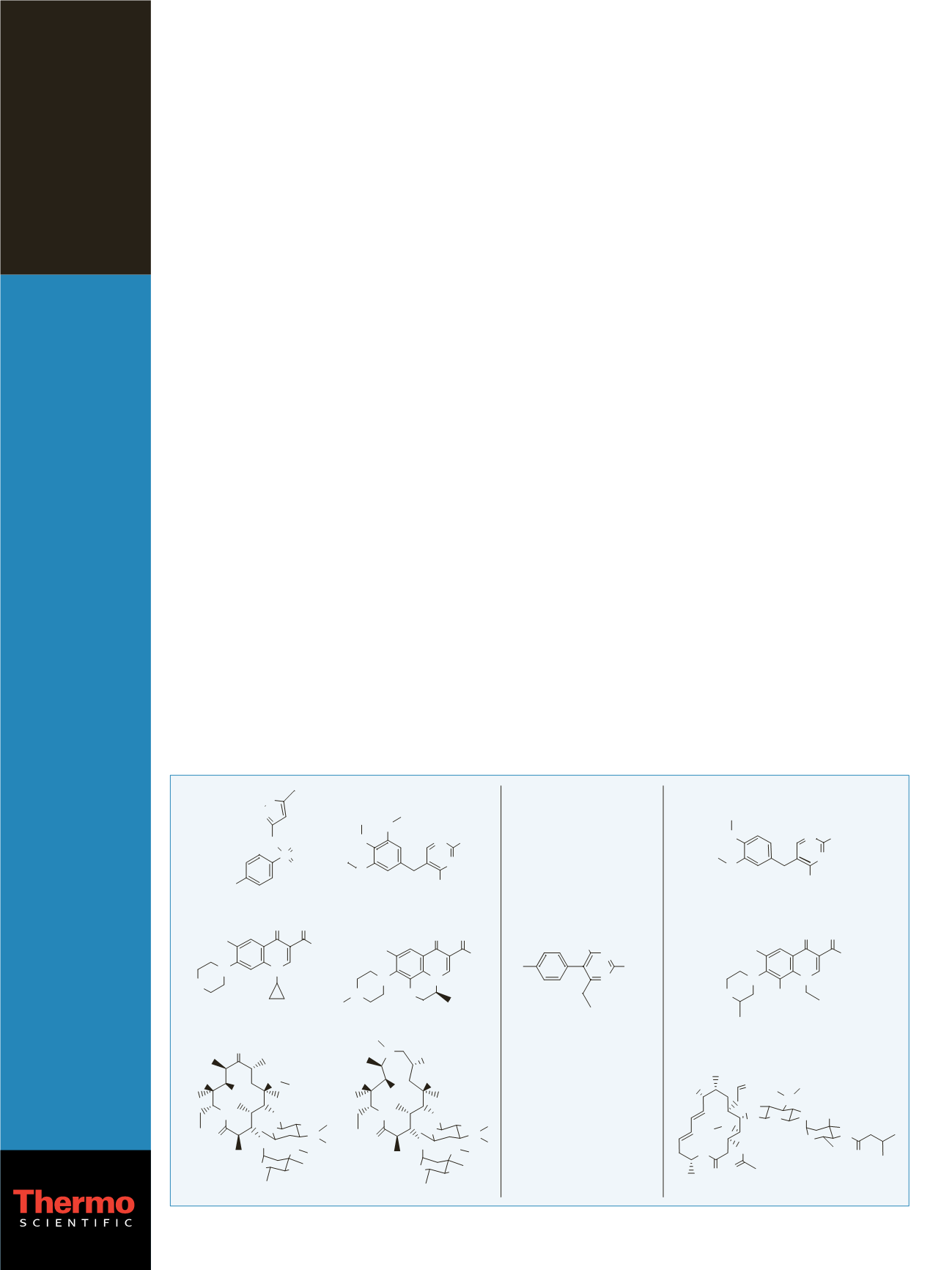

LC-MS/MS Analysis of Anti-Infectives
In Raw and Treated Sewage
P.A. Segura
1
, A.Garcia Ac
1
, A. Lajeunesse
2
, D.Ghosh
3
, C. Gagnon
2
and S. Sauvé
1
1
Département de Chimie, Université de Montréal, C.P. 6128, succursale Centre-ville, Montréal, QC, Canada H3C 3J7
2
Centre Saint-Laurent, Environnement Canada, 105, rue McGill, Montréal, QC, Canada H2Y 2E7
3
Thermo Fisher Scientific, San Jose, CA, USA
Application
Note: 372
Key Words
• TSQ Quantum
Ultra
™
• Surveyor HPLC
™
• Antibiotics
• SPE
Introduction
“Anti-infectives” is a general term that refers to several
classes of biologically active compounds used to treat
or prevent infections. Therapeutic agents such as anti-
microbials (synthetic) and antibiotics (natural or
semi-natural) are examples of anti-infectives.
The widespread utilization of anti-infectives in urban
centers as well as their resistance to biodegradation or
elimination in wastewater treatment plants (WWTPs) has
led to their appearance in effluents and surface waters
[1-3]
.
In the last few years there has been a growing concern
about the environmental fate and the possible effects of
these agents on the aquatic environment
[4,5]
.
The first report on the occurrence of anti-infective
traces in the aquatic environment was published as early
as 1983
[6]
. A later study
[7]
acknowledged that pharmaceu-
ticals would enter the water cycle mainly via a “domestic
route” (
i.e.
by the excreta of individuals taking medication
at homes, hospitals or clinics). It is therefore important to
know the amounts of these substances released in the
aquatic environment to be able to evaluate potential effects.
A sensitive and robust method was developed for the
determination of some of the most prescribed anti-infec-
tives in trace amounts (lower nanogram-per-liter range) in
raw and treated wastewaters.
Goals
•
Quantify several anti-infectives at the lower nanogram-
per-liter level in raw and treated wastewaters.
•
Apply two specific single reaction monitoring mode
(SRM) transitions and their peak ratio to avoid the
presence of false positives.
Method
Raw sewage (north and south influent) was collected and
treated (effluent) 24-h composite samples at the municipal
wastewater treatment plant of the City of Montréal
(Québec, Canada). This plant has physico-chemical treat-
ments only and its effluent is one of the largest in North
America. We analyzed six of the most prescribed com-
pounds (sulfamethoxazole, trimethoprim, ciprofloxacin,
levofloxacin, clarithromycin and azithromycin) (Figure 1),
by using solid phase extraction (SPE) and liquid chro-
matography-tandem mass spectrometry (LC-MS/MS).
The compounds were selected based on drugstore sales.
NH
2
S
O
O HN
N
O
O
O
O
N
N NH
2
N H
2
N
O
O H
F
N
HN
O
N
O
O H
F
N
N
O
O
N
N
N H
2
N H
2
C l
O
O
O
O
HO
O H
O
O
OH
N
O O H
O
O
O
N
O
OH
HO
OH
O
O
OH
N
O OH
O
O
Sulfamethoxazole
Trimethoprim
Ciprofloxacin
Levofloxacin
Pyrimethamine (IS)
Clarithromycin
Azithromycin
O
O
N
N NH
2
NH
2
N
O
OH
F
N
HN
O
F
Diaveridine (IS)
Lomefloxacin (IS)
Josamycin (IS)
O
O
HO
O
O
O
O
O O O
OH
N
O
O
OH
O
a.
b.
c.
Figure 1: Molecular structures of the anti-infectives studied (a), the surrogate standard (b), and the internal standards (c).



















